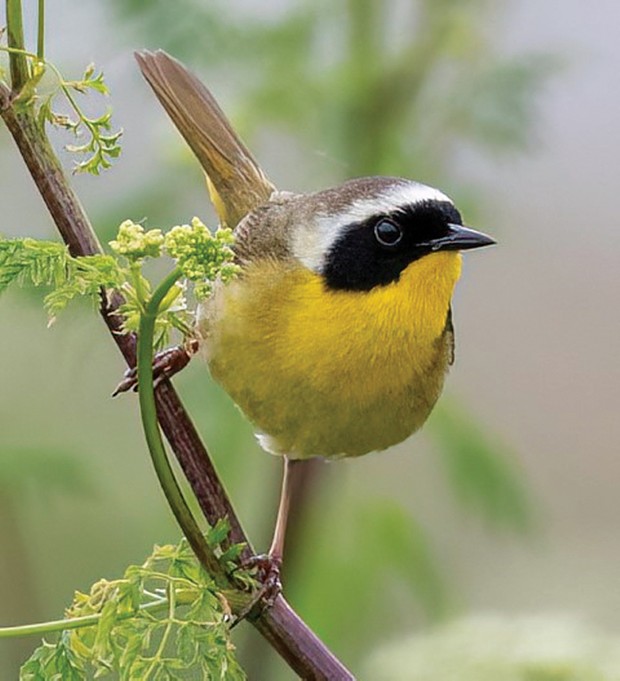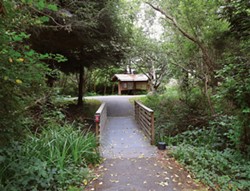[
{
"name": "Top Stories Video Pair",
"insertPoint": "7",
"component": "17087298",
"parentWrapperClass": "fdn-ads-inline-content-block",
"requiredCountToDisplay": "1"
}
]
It's the time of year schoolkids love and birders dread: summer vacation.
Diehard birders wait in vain for rare bird notifications but their phones have gone eerily silent. It's not that the birds aren't out there; they're just busy nesting, fledging, molting and doing other birdy things behind a thick veil of foliage. For most birders, summer is a good time to tackle home projects, like that deck that's been half-finished for years, or take up other hobbies, such as stamp collecting.
But there are still scenic local places to visit and, with persistence, get an eyeful of summer's most colorful birds. Three of my favorite spots share some common traits: They're full of lush greenery, have a serene ambiance and are accessible for a wide range of mobilities. Ready to do a little exploring? Put on your birding shoes and let's go.
Lhiwetgut
This small park overlooking the Mad River is not only a birding hotspot but a fascinating lesson in the deep connection between Indigenous people and the river known as Baduwa't in Soulatluk, the Wiyot language. The park name was chosen by the Wiyot tribe.
From a parking area at the west end of School Road in McKinleyville, a paved path loops through a rich meadow of native grasses and shrubs. American and Lesser Goldfinches make bright spots of color as they feast on seeds and chatter during their characteristic dipping flights. The path leads to an overlook with dramatic views of the river; there's a picnic table and benches for a little lunch or to just to sit a spell. Numerous bird species can be found in this bustling riparian habitat, including herons and egrets, Ospreys, dabbling ducks like mallards and divers like mergansers and a nice variety of shorebirds that feed on the mudflats at low tide.
The paved trail drops down to second overlook with a long view downriver toward the Pacific Ocean. Sometimes this seaward vista offers up some fun surprises, like the Long-tailed Duck I saw here last year. Then the path circles back to the starting point, while an unpaved trail branches off to the south through a peaceful corridor of young alders and willows, a great area to pick up a few warblers and maybe a flycatcher or two. The trail ends rather abruptly at a channel built as part of the 2022 riparian restoration effort, a project that created a robust ecosystem for fish and other wildlife. This is a good place to turn around for today.
Terrain and accessibility: The paved loop is about 1/5 of a mile long and is wheelchair accessible, though with some hilly sections. The unpaved path is wide with a dirt and gravel surface. It adds roughly 200 yards with a quick drop in elevation before leveling out. On-leash dogs are welcome at the park.
Potawot Health Village
Located at 1600 Weott Way in Arcata, Potawot combines the United Indian Health Services clinic with a 20-acre restoration area known as Ku' wah-dah-wilth ("comes back to life" in Soulatluk). Almost 2 miles of trails wind through the restoration area, taking visitors through coastal meadows and past thick growths of spruce, maple and alder. Wooden bridges span seasonal wetlands that even during the dry summer months are home to riparian-loving birds like Common Yellowthroats and Western Flycatchers. It's a tranquil spot that includes an organic community garden and orchard, reflecting the village's philosophy that the health of the environment is intrinsically tied to the health of the community.
It's also a birding paradise, though you might have to look a little harder right now to spot the Cedar Waxwings munching on berries and the Orange-crowned Warblers singing from the branches of a willow tree. But patience is a perfect partner for the serenity of the location.
Terrain and accessibility: The trail system is wheelchair-accessible right from the parking lot and most of the trails near the clinic buildings are paved. Branching off from the paved loop are additional trails that are narrow in spots and have a hard-packed dirt surface. Ku' wah-dah-wilth is open from dawn till dusk; dogs, bicycles and recreational wheels aren't allowed, and smoking is not permitted.
Mad River Fish Hatchery
There's a lot to see at this popular Blue Lake attraction located at the end of Hatchery Road. Established in 1971 and managed by the California Department of Fish and Wildlife, the hatchery offers self-guided tours of the concrete fish runs full of fingerling salmon and steelhead. It also has a nice picnic area and a rarity among birding locations, flush toilets. Be still my heart.
There are good birds to be seen at the facility itself, especially the Purple Martins that return year after year to nest there. The largest North American swallow, Purple Martins have a sweet warbling call that is sung on the wing as the birds swoop and soar over their territory. The males are entirely deep purple, while the females are gray-brown with dark blue highlights.
Before recent improvements to the fencing around the fish runs, fish-eating birds like Ospreys and Belted Kingfishers could be found perched atop the chain link enclosure like hungry diners at an all-you-can-eat buffet. Now that there's no such thing as a free lunch, you might have to look a little further afield, like down by the boat launch reached via a trail that starts at a gate in the fencing near the restrooms. Listen for the distinctive rattling call of the kingfisher and the high-pitched "kew-kew-kew" of the Osprey as they patrol the river. The trail continues along the Mad through a mix of open meadow and deciduous saplings, a great place to see Wilson's warblers, noisy Yellow-breasted Chats and the occasional Warbling Vireo. A left turn at the "T" will bring you back to Hatchery Road; take another left to return to the hatchery, passing a lovely little waterfall along the way.
Terrain and accessibility: The hatchery itself, including the concrete path to the boat launch, is paved and wheelchair accessible. Past the boat launch, the trail is mostly level with a dirt and gravel surface. The full loop is a pleasant mile. Take note, though: Poison oak grows in lush profusion along the trail edges. If you're one of the unfortunate souls who is susceptible to the urushiol oil in the leaves and stems, be sure to stay in the center of the trail. That being said, if you've brought your dog, you can tiptoe between the glossy three-leafed clusters like a high-wire performer and you'll still likely pick up the oil from your pup's coat. Don't ask me how I know this, just stock up on the calamine lotion.
So, take heart, birders and wanderers, and get ready to dust off your binoculars, put away your beer cap collection and do a little adventuring close to town. The birds of summer await you.
Sarah Hobart (she/her) is a freelance writer based in Humboldt County.
more from the author
-
Condors Over Arcata
- Jun 6, 2024
-
A Chime of Wrens
- Apr 11, 2024
-
Bird Names for Everyone
- Feb 29, 2024
- More »
Latest in Get Out
Readers also liked…
-
A Walk Among the Spotted Owls
- Apr 27, 2023

































